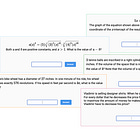Digital SAT Math: Reflections on the First Year
Now that we've had over a year of real tests, what do we know?
It’s been over a year now since the first administration of the digital SAT in the US1 . This seems like a good time to stop and think about what we’ve learned so far.
This is how the content is distributed across the nine Mathchops categories:
These stats are based on the tags I made for Bluebook tests 4 through 10. But it’s interesting to note how the most recent four compare to the first four that were released. See this post for longer descriptions of the problem types:
Five Types On The Rise
Congruent triangles, similar triangles, order matters: These ‘light proof’ questions appeared on every one of the new tests. I now make sure to teach ‘order matters’ to all students.
Infinite/no solutions: These have always been important, both in systems and single equations, but they seem to appear on every test now.
Area of a circle: These were strangely absent from the first batch, but now appear roughly half of the time. We’ve also seen some more exotic volume questions (cone and sphere).
Square root functions: I believe they actually did have a tough one of these on one of the PSATs, but I couldn’t tell if students really needed to know them. But now they’ve shown up three more times on recent tests.
Systems: By my count, there were 21 on the first four tests and 29 on the most recent four. I don’t think this changes the way I teach, but it’s interesting — now that Desmos is an option, I thought they might stop asking so many questions about systems.
Five Types On The Decline
These all appeared less than half as frequently, if they appeared at all:
Factor by grouping
Perfect square trinomial
Radians/degrees
Average sum trick
Pythagorean triples, 30_60_90
General Observations
It’s almost entirely composed of material students have already seen:
There’s only so much official material. We have 7 official SATs in the Bluebook app, plus a couple PSATs and a lot of questions in the Educator Bank. You may need to find a third-party test provider you like, such as Score Smart or Test Innovators.
There are lots of easy points on the Math side of the test. Maybe this is just my bias, but if you told me a student had increased her scores by 200 points, I’d guess that at least 120 of them came from Math.
You need to use a lot of different resources in order to target 710+ scores.
What have you noticed so far? Please comment below!
It was released one year earlier internationally.






Great analysis into SAT Math trends! I especially like (and agree with) your topics on the rise.